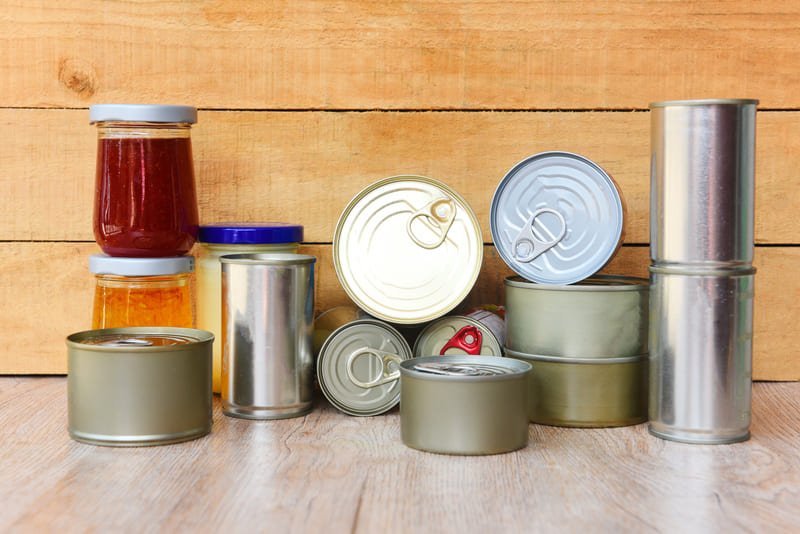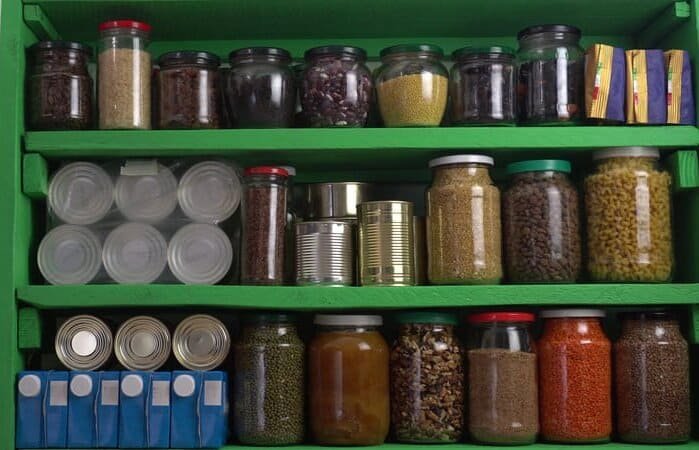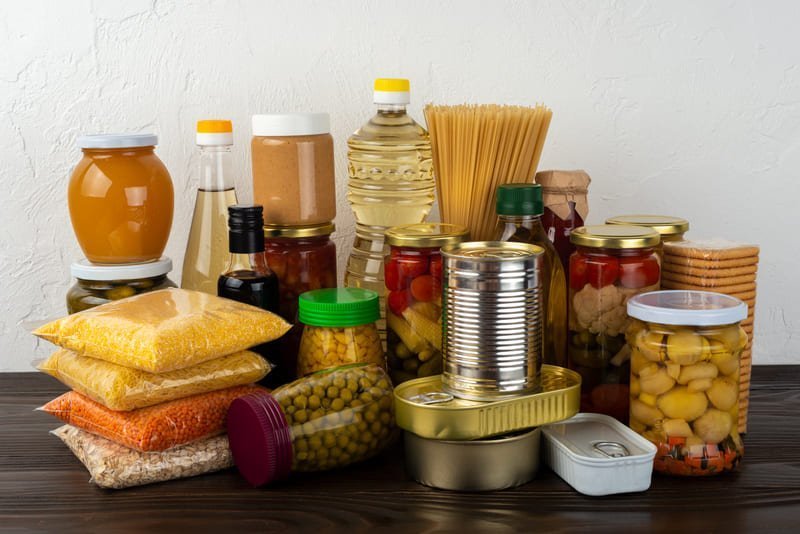When it comes to stocking up your pantry, it’s essential to have a supply of non-perishable items that can last for an extended period. Non-perishable foods, also known as pantry staples, are a must-have for any emergency food supply or as a reliable source of sustenance in challenging times.
Non-perishable foods are characterized by their long shelf life and ability to remain stable without refrigeration. These shelf-stable products include canned goods, dry goods, and food with extended shelf life that can be stored for months or even years. They are an essential part of every well-prepared pantry.
By having a well-stocked supply of non-perishable essentials, you can be prepared for any situation that may arise. Whether it’s a natural disaster or a personal emergency, these non-perishable foods will provide you with sustenance and peace of mind. Let’s dive into some of the healthiest non-perishable foods you should consider adding to your pantry.
Key Takeaways:
- Non-perishable foods are essential for smart stocking and emergency preparedness.
- Pantry staples have a long shelf life and don’t require refrigeration.
- Canned goods, dried fruits and vegetables, and nuts and seeds are great options for non-perishable essentials.
- By having a variety of non-perishable items, you can create a well-rounded stockpile of survival food.
- Remember to rotate your stock regularly to maintain freshness and optimal food quality.
Dried and Canned Beans
When it comes to non-perishable foods with a long shelf life, dried and canned beans are a staple in any pantry. Not only are they versatile and delicious, but they also pack a nutritional punch, providing an excellent source of fiber, plant-based protein, and essential nutrients.
Canned beans can be conveniently stored at room temperature for 2-5 years. This means you can always have a quick and easy protein option ready to go for those busy weeknight meals or last-minute recipe ideas. Whether you’re making a hearty bean chili, a comforting soup, or a savory dip, canned beans are a go-to ingredient that adds both texture and flavor to any dish.
Dried beans, on the other hand, have an even longer shelf life, lasting 10 years or more when stored properly. These little powerhouses of nutrition offer endless possibilities in the kitchen. From classic black beans and pinto beans to chickpeas and lentils, the choices are abundant. Soak and cook them to your preferred texture, and you’ll have a versatile ingredient that can elevate your salads, grain-based dishes, and soups.
| Benefits of Dried and Canned Beans |
|---|
| Fiber: Beans are an excellent source of dietary fiber, promoting healthy digestion and keeping you fuller for longer. |
| Protein: They are a valuable plant-based protein source, making them an ideal option for vegetarian or vegan diets. |
| Nutrients: Dried and canned beans contain essential nutrients like iron, magnesium, folate, and potassium, contributing to overall health and well-being. |
So, whether you’re preparing for a long-term emergency situation, looking to stock up on non-perishable foods, or simply want to add a nutritious and versatile ingredient to your everyday cooking, dried, and canned beans are the way to go.
Remember, having a well-stocked pantry with long-lasting, non-perishable essentials is a smart and practical choice. And when it comes to beans, you can rest assured that you’re investing in a nutrient-dense food that can fuel your body and satisfy your taste buds.
Nut Butters
 When it comes to versatile and nutrient-dense foods, nut butters are a pantry staple that should not be overlooked. Whether you enjoy peanut butter, almond butter, or cashew butter, these creamy spreads offer a multitude of benefits.
When it comes to versatile and nutrient-dense foods, nut butters are a pantry staple that should not be overlooked. Whether you enjoy peanut butter, almond butter, or cashew butter, these creamy spreads offer a multitude of benefits.
One of the key advantages of nut butters is their shelf life. Commercial peanut butter, for example, can last up to 9 months when stored at room temperature. Almond butter, on the other hand, can maintain its quality and taste for up to 1 year. This makes nut butters an excellent long-lasting option to keep on hand.
But what exactly makes nut butters so healthy? These delicious spreads are packed with essential nutrients, including healthy fats, protein, vitamins, minerals, and antioxidants. The healthy fats found in nut butters, such as mono- and polyunsaturated fats, can support heart health and provide sustained energy.
Nut butters are also a great source of protein, which is essential for building and repairing tissues, as well as supporting immune function. Additionally, they contain a variety of vitamins and minerals, such as vitamin E, magnesium, and potassium, which contribute to overall health and wellbeing.
Whether you spread it on toast, dip your favorite fruits in it, or use it as an ingredient in sauces and dressings, nut butters offer endless possibilities. They are a delicious and convenient way to incorporate healthy fats, protein, and various nutrients into your diet.
Include a table showcasing the different types of nut butters, their average shelf life, and some of their nutritional highlights:
| Nut Butter | Shelf Life | Nutritional Highlights |
|---|---|---|
| Peanut Butter | Up to 9 months | Rich in healthy fats and protein |
| Almond Butter | Up to 1 year | Good source of vitamin E and magnesium |
| Cashew Butter | Up to 1 year | Provides copper and zinc |
Remember to store your nut butters in the pantry, away from direct sunlight and heat, to maintain their quality and taste. With their long shelf life and impressive nutritional profile, nut butters are a must-have addition to any well-stocked pantry.
Dried Fruits and Vegetables
 When it comes to non-perishable options, dried fruits and vegetables are a top choice. With their extended shelf life and versatility, they offer a convenient and nutritious snacking solution.
When it comes to non-perishable options, dried fruits and vegetables are a top choice. With their extended shelf life and versatility, they offer a convenient and nutritious snacking solution.
Dried fruits and vegetables have a longer shelf life compared to their fresh counterparts. Most dried fruit can be safely kept at room temperature for up to 1 year, while dried vegetables can be stored for about half that time. This longevity makes them an ideal choice for stocking your pantry.
Not only are they non-perishable, but dried fruits and vegetables are also incredibly versatile. Enjoy them as a satisfying snack on their own, or add them to trail mix for an extra burst of flavor and nutrition. They can also be rehydrated and added to soups or stews, providing a delicious boost of nutrients when fresh produce is not available.
Whether you’re looking for a quick energy boost or a way to add variety to your meals, dried fruits and vegetables are the perfect solution.
Benefits of Dried Fruits and Vegetables:
- Extended shelf life
- Non-perishable
- Convenient snack
- Versatile ingredient for trail mix
- Can be rehydrated and added to soups or stews
With their nutrient-rich content and long shelf life, dried fruits and vegetables are a must-have for any well-stocked pantry. Whether you’re planning a hiking trip or simply need a healthy snack on hand, these non-perishable options won’t disappoint.
Canned Fish and Poultry
 When it comes to non-perishable protein sources, canned fish and poultry are a convenient and lightweight option. While fresh fish and poultry are highly perishable, their canned counterparts have a long shelf life and can be safely stored without refrigeration.
When it comes to non-perishable protein sources, canned fish and poultry are a convenient and lightweight option. While fresh fish and poultry are highly perishable, their canned counterparts have a long shelf life and can be safely stored without refrigeration.
Canned fish, such as tuna and salmon, can last up to 5 years at room temperature. These canned varieties are not only a great source of protein but also rich in omega-3 fatty acids, which are beneficial for heart health. Whether you’re making a quick sandwich or adding them to a pasta dish, canned fish provides a nutritious and flavorful alternative.
Seafood lovers can also opt for seafood in retort pouches, which have a shelf life of up to 18 months. These lightweight pouches are easy to carry and can be enjoyed straight out of the package or incorporated into various recipes. Additionally, retort pouches also offer options for canned chicken and other meats, providing a versatile range of non-perishable protein choices.
Whether you’re preparing for an outdoor adventure or building an emergency food supply, canned fish and poultry are reliable options. With their extended shelf life and the convenience of retort pouches, you can enjoy the nutritional benefits of fish and poultry anytime, anywhere.
| Benefits of Canned Fish and Poultry: |
|---|
| Non-perishable: With a shelf life of up to 5 years for canned fish and up to 18 months for seafood in retort pouches, they are excellent options for long-term storage. |
| Lightweight: The compact nature of canned fish and poultry makes them lightweight and easy to carry, making them ideal for outdoor activities and on-the-go meals. |
| Variety: Canned fish and poultry offer a range of options, from tuna and salmon to chicken and seafood, allowing you to diversify your non-perishable protein sources. |
| Convenience: Canned fish and poultry can be enjoyed straight from the can or incorporated into various dishes, providing a versatile and convenient protein option. |
Nuts and Seeds
When it comes to non-perishable food options, nuts and seeds are a must-have. They are not only delicious but also highly nutritious, making them an excellent choice for you to snack on. Whether you’re on the go or looking for a quick energy boost, nuts and seeds are portable and convenient.
These nutrient-dense powerhouses are packed with vitamins, minerals, and healthy fats. They provide a satisfying crunch and are known for their high protein content, which is essential for repairing and building tissues. With their long shelf life, you can stock up on various types of nuts and seeds to enjoy at any time.
Benefits of Nuts and Seeds
Here are some of the reasons why nuts and seeds are an excellent addition to your non-perishable food stash:
- Rich in nutrients: Nuts and seeds are nutrient powerhouses, packed with essential vitamins, minerals, and antioxidants. They contain a wide range of beneficial nutrients like magnesium, zinc, vitamin E, and omega-3 fatty acids.
- High in healthy fats: Nuts and seeds are a great source of healthy fats, including monounsaturated and polyunsaturated fats. These fats help support heart health and provide a feeling of satiety.
- Good source of protein: Nuts and seeds are plant-based sources of protein, making them an excellent option for vegetarians and vegans. They can be a satisfying snack or added to meals to increase protein intake.
- Versatile: Nuts and seeds can be enjoyed in various ways. You can eat them as a standalone snack, add them to salads or smoothies, or use them in baking to enhance the flavor and texture of your recipes.
Shelf Life of Nuts and Seeds
The shelf life of nuts and seeds can vary depending on the specific type and storage conditions. On average, they can last about 4 months at room temperature or in a cool, dry place. However, it’s essential to store them properly to maintain their freshness and prevent them from going rancid.
To extend the shelf life of nuts and seeds, consider storing them in airtight containers or resealable bags in the refrigerator or freezer. This can help preserve their flavor and texture for a more extended period. Remember to check for any signs of spoilage, such as a rancid smell or taste, before consuming.
Ways to Enjoy Nuts and Seeds
Here are some ideas for incorporating nuts and seeds into your diet:
- Snack on a handful of mixed nuts and seeds for a quick energy boost.
- Sprinkle chopped nuts or seeds on top of salads, yogurt, or oatmeal for added texture and flavor.
- Blend nuts or seeds into smoothies for a creamy and nutritious addition.
- Use ground nuts or seeds as a coating for chicken or fish for a flavorful twist.
- Add chopped nuts or seeds to your favorite baked goods, such as cookies or muffins, for an extra crunch.
With their versatility and nutritional benefits, nuts and seeds are a fantastic addition to any non-perishable food collection. They provide a convenient way to enjoy high-calorie snacking while promoting overall health and well-being.
Grains
 When it comes to non-perishable food staples, grains are a must-have. Not only do they have a long shelf life, but they are also incredibly versatile and beneficial for your health.
When it comes to non-perishable food staples, grains are a must-have. Not only do they have a long shelf life, but they are also incredibly versatile and beneficial for your health.
Whole grains like oats, rice, barley, and farro are excellent choices for your pantry. Unlike perishable carb sources like bread, whole grains can be stored for extended periods without spoiling. For example, brown rice can be kept at 50–70°F for up to 3 months, while farro lasts up to 6 months at room temperature.
One of the great things about grains is their versatility. They can be added to soups, salads, and casseroles, making them a perfect addition to any meal. Whether you’re looking for a hearty breakfast, a filling lunch, or a wholesome dinner, grains can be the foundation of a delicious and nutritious dish.
But it’s not just their long shelf life and versatility that makes grains a pantry staple. Whole grains are also rich in fiber, which is essential for a healthy digestive system. Fiber helps regulate blood sugar levels, supports a healthy weight, and may even reduce the risk of certain diseases, like heart disease and type 2 diabetes.
So, stock up on a variety of whole grains to ensure you always have a nutritious and delicious meal option on hand.
Benefits of Whole Grains:
- Long shelf life
- Versatile for various dishes
- Rich in fiber for a healthy digestive system
- Potential reduction in the risk of certain diseases
| Grain | Shelf Life |
|---|---|
| Brown Rice | Up to 3 months at 50–70°F |
| Farro | Up to 6 months at room temperature |
So, why not add some grains to your pantry today? They will not only provide you with lasting sustenance but also offer a multitude of culinary possibilities.
Conclusion
Stocking up on non-perishable items is a smart and practical way to ensure that your pantry is well-stocked with essential food items for any situation. Non-perishable foods have a long shelf life and don’t require refrigeration, making them perfect for emergencies, camping trips, and as a backup during challenging times.
By including a variety of non-perishable foods like canned goods, dried fruits and vegetables, nuts and seeds, and shelf-stable milk, you can create a well-rounded stockpile of pantry essentials. Canned goods offer convenience and versatility, while dried fruits and vegetables provide nutritious snacks and add flavor to your meals. Nuts and seeds are portable and packed with nutrients, and shelf-stable milk can be used in various recipes or enjoyed on its own.
Remember to check expiration dates regularly and rotate your stock to ensure freshness and optimal food quality. Smart stocking means having a diverse selection of non-perishable items that meet your family’s nutritional needs and preferences. With a well-stocked pantry, you will be prepared for any situation that may arise, whether it’s a sudden power outage, limited access to fresh food, or unexpected events.
FAQ
What are non-perishable items?
Non-perishable items are food products that have a long shelf life and do not require refrigeration. They are ideal for emergencies, camping, and as a backup during challenging times.
What are some examples of pantry staples or non-perishable essentials?
Pantry staples or non-perishable essentials include canned goods, dried fruits and vegetables, nuts and seeds, and shelf-stable milk.
Why are non-perishable foods important in emergency situations?
Non-perishable foods are important in emergency situations because they can be stored for long periods without spoiling. They provide sustenance and nutrition when fresh food is not readily available.
How long do dried and canned beans last?
Canned beans can be kept at room temperature for 2–5 years, while dried beans can last 10 or more years.
What are the benefits of nut butters?
Nut butters are a good source of healthy fats, protein, vitamins, minerals, and antioxidants. They can be stored in the pantry and are great for snacking or adding to meals.
How long can dried fruits and vegetables be kept?
Most dried fruit can be safely kept at room temperature for up to 1 year, and dried vegetables can be kept for about half that time. They are non-perishable and can be enjoyed as a snack or added to trail mix.
What is the shelf life of canned fish and poultry?
Canned fish can last up to 5 years at room temperature, and seafood in retort pouches has a shelf life of up to 18 months. Chicken and other meats can also be found in retort pouches.
How long do nuts and seeds last?
Different varieties of nuts and seeds have varying shelf lives, but on average, they can last about 4 months at or near room temperature. They are great for high-calorie snacking and can be added to various dishes for extra flavor and nutrition.
What are some examples of grains with a long shelf life?
Examples of grains with a long shelf life include oats, rice, barley, and farro. They can be added to soups, salads, and casseroles and are beneficial for health due to their high fiber content.












